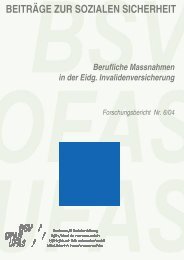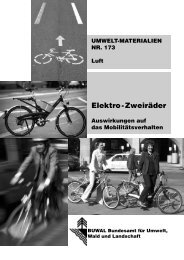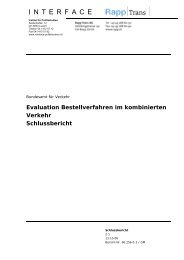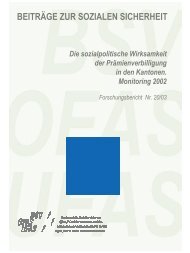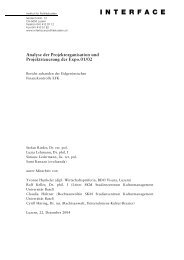Der Übergang in den Ruhestand - Wege, Einflussfaktoren und
Der Übergang in den Ruhestand - Wege, Einflussfaktoren und
Der Übergang in den Ruhestand - Wege, Einflussfaktoren und
Sie wollen auch ein ePaper? Erhöhen Sie die Reichweite Ihrer Titel.
YUMPU macht aus Druck-PDFs automatisch weboptimierte ePaper, die Google liebt.
Summary <strong>Der</strong> <strong>Übergang</strong> <strong>in</strong> <strong>den</strong> <strong>Ruhestand</strong><br />
Early retirement<br />
24.6 % of the 1,960 persons who had reached legal retirement age chose early retirement.<br />
Results show that 30.8 % were forced to retire early, whereas 69.2 % opted freely for this<br />
solution. Both voluntary and enforced early retirement is usually l<strong>in</strong>ked to health problems.<br />
The second most often quoted reason is company restructur<strong>in</strong>g.<br />
A bivariant and multivariant analysis of early retirement factors shows that gender is an important<br />
element <strong>in</strong> early retirement decisions. All participants considered, women seem to<br />
have four times less of a chance of early retirement than men.<br />
For men the decision to retire early is best expla<strong>in</strong>ed by sociodemographic and socioprofessional<br />
factors. An active approach to leisure activities (at time of survey), a dim<strong>in</strong>ish<strong>in</strong>g<br />
household between 60 and retirement age, bad health or draw<strong>in</strong>g an <strong>in</strong>validity (IV) pension<br />
at age 60, are the factors that most strongly <strong>in</strong>crease the likelihood of early retirement<br />
for men. Other factors are: last place of employment <strong>in</strong> a large company, and/or work <strong>in</strong><br />
transport, communications or education.<br />
For women economic factors, i.e. occupational pension plan (2nd pillar) retirement assets<br />
seem to best expla<strong>in</strong> retirement age. The higher this amount, the greater the likelihood of<br />
early retirement for women.<br />
On average early retirement is taken 3.04 years before the legal age, although relevant profiles<br />
differ for women and men. The most common value for women is 2 years prior to legal<br />
retirement age, correspond<strong>in</strong>g to a retirement age of 60 for most of the birth cohorts studied.<br />
For men the highest distribution value is 3 years, i.e. retirement at 62.<br />
Partial retirement<br />
Only 1.4% of participants past retirement age chose the partial retirement solution; most of<br />
these expla<strong>in</strong>ed their decision by the wish to draw out the retirement process. Health<br />
problems mak<strong>in</strong>g full time work impossible were <strong>in</strong>voked by almost 20%, whereas 8.5%<br />
retired to make room for the young.<br />
“Regular” retirement<br />
45.1% of retired survey participants worked until at least legal retirement age, regardless of<br />
whether they cont<strong>in</strong>ued work<strong>in</strong>g or not afterwards. A gradual reduction of work<strong>in</strong>g time before<br />
legal retirement age was observed <strong>in</strong> 8.3% of the cases.<br />
Retirement prior to legal retirement age<br />
Most persons who stop work<strong>in</strong>g before reach<strong>in</strong>g legal retirement age are women who gave<br />
up their jobs while young to take care of household and children. Unemployment and health<br />
problems play no significant role <strong>in</strong> this pathway.<br />
Work<strong>in</strong>g after legal retirement age<br />
The proportion of pensioners who cont<strong>in</strong>ue work<strong>in</strong>g after reach<strong>in</strong>g legal retirement age is<br />
over 16%, with somewhat more men than women. The study shows that the decision to<br />
work after reach<strong>in</strong>g legal retirement age is at least partly l<strong>in</strong>ked to lower <strong>in</strong>come status. Almost<br />
all variables <strong>in</strong> the model apply to persons <strong>in</strong> lower <strong>in</strong>come brackets (no executive<br />
function, work <strong>in</strong> a small company, <strong>in</strong> the agricultural or forestry sector, <strong>in</strong>sufficient 2 nd pillar<br />
retirement assets). One may suppose that work after legal retirement age is often motivated<br />
by economic reasons, a supposition confirmed explicitly by 29.7% of persons work<strong>in</strong>g<br />
XXVIII




